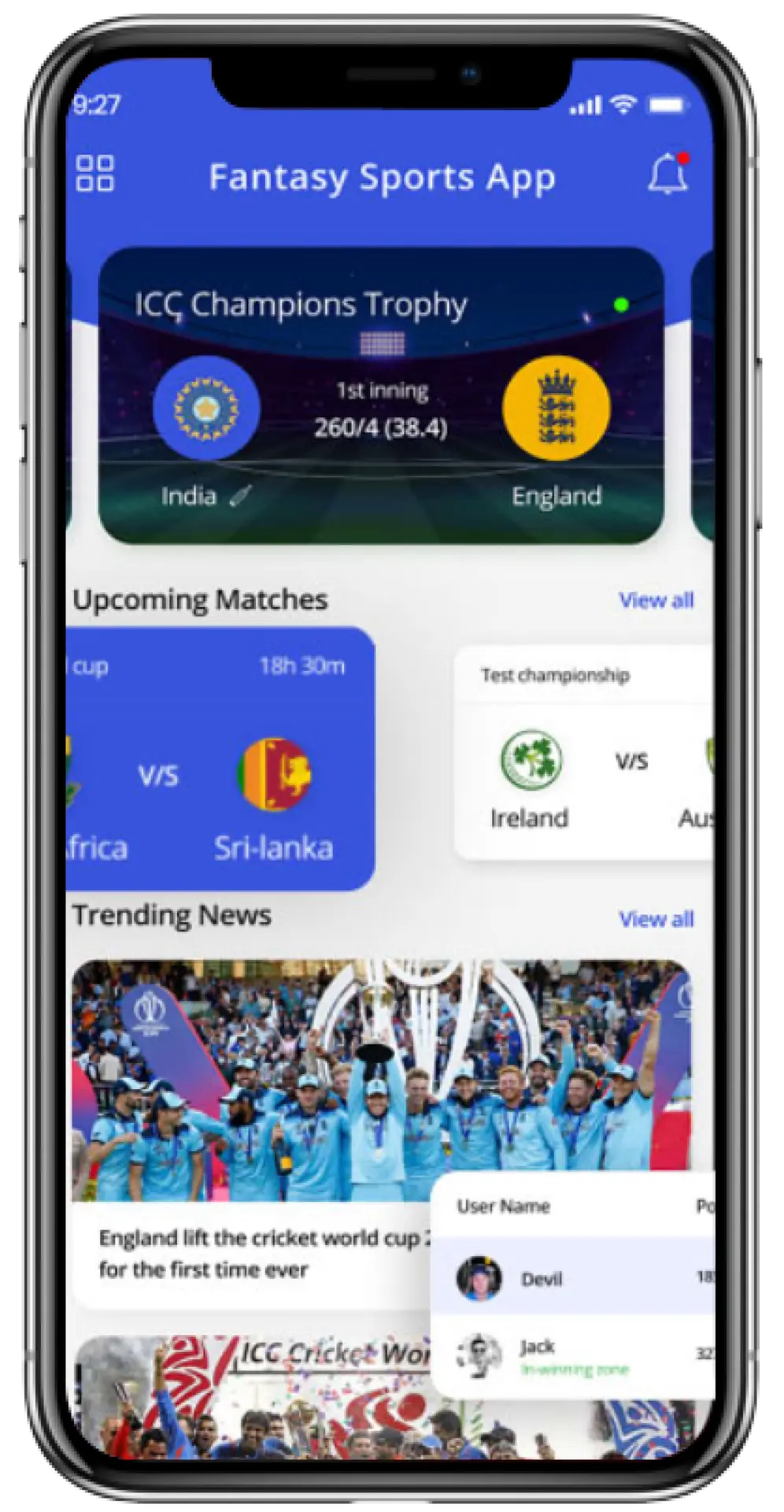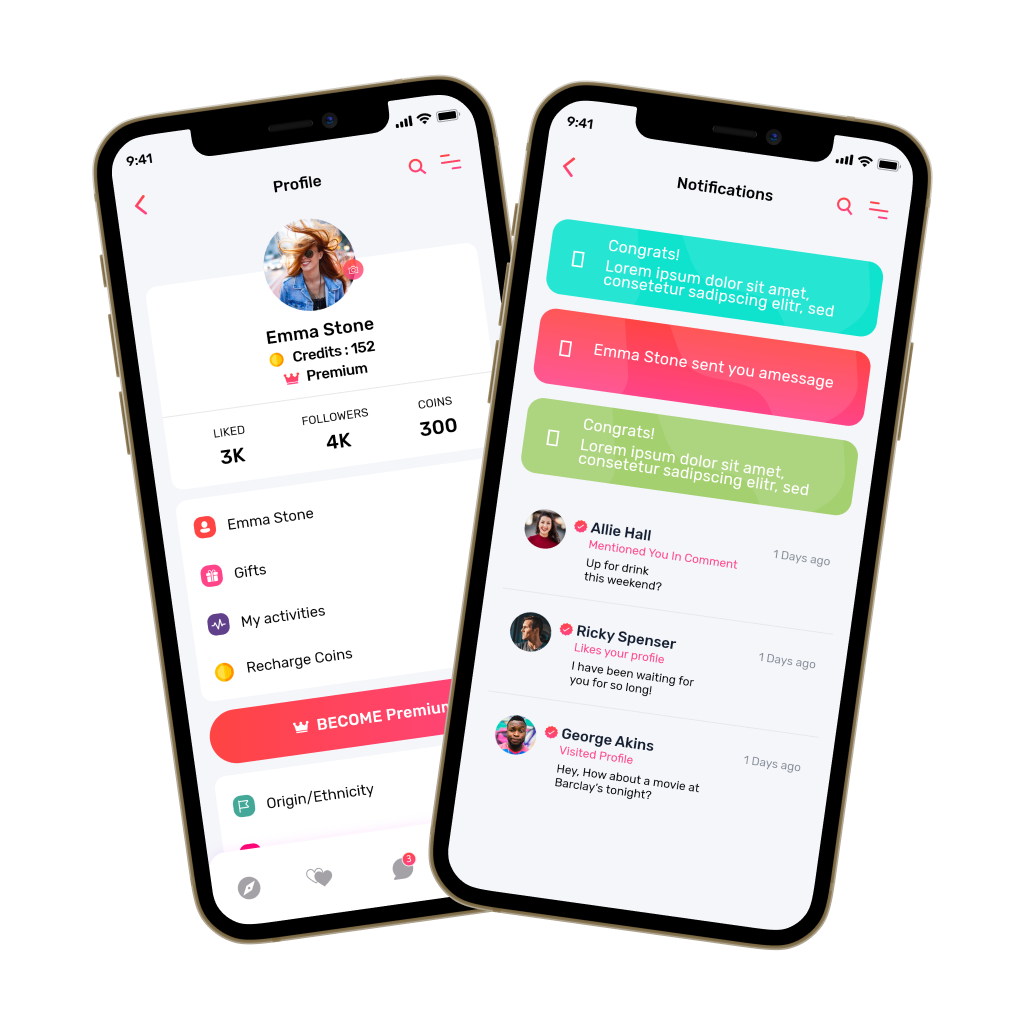There is a clear shift in how children learn today as they are encouraged to think freely and turn their ideas into meaningful stories. Inspiring them to write can be challenging because many will lose interest when the process feels too rigid. Creative writing apps like Night Zookeeper now offer a new path by making learning feel playful and technically engaging. These platforms often use animated character builders and guided writing prompts that children can follow with confidence.
AI-based evaluation systems also provide supportive feedback, helping young writers improve at a steady pace. Interactive missions turn each writing session into an experience that feels rewarding. This approach helps learning feel natural and curiosity-driven rather than forced.
We’ve spent years building Ed-tech platforms powered by advanced technologies such as natural language processing frameworks and adaptive learning systems. With this hands-on experience, we’re putting together this blog to walk you through the essential steps of developing a creative writing app like Night Zookeeper. Let’s dive in!
Key Market Takeaways for Creative Writing Apps
According to WiseGuyReports, the market for children’s creative writing apps is growing rapidly as more families and schools rely on digital tools to support early literacy. Educational and creative apps aimed at kids reached an estimated USD 1.66 billion in 2024 and are expected to approach USD 2.1 billion in 2025. With strong long-term growth projected, the category reflects a clear demand for tools that build both imagination and communication skills from an early age.
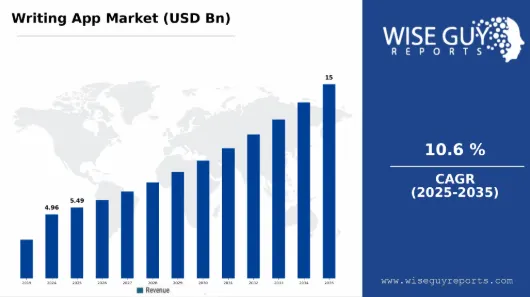
Source: WiseGuyReports
A major driver behind this rise is the way these apps turn writing into something playful rather than intimidating. Interactive prompts, character creation, and story-building activities help children practice writing without feeling like they’re doing a formal assignment. This balance of learning and exploration keeps kids engaged and gives them room to experiment with ideas in their own voice.
Platforms such as Night Zookeeper and Storybird show how effective this approach can be. Night Zookeeper immerses children in a fantasy world where their stories shape the adventure, supported by gentle guidance from tutors.
Storybird sparks creativity through curated artwork that encourages kids to build stories around images, helping them develop vocabulary and narrative structure. Together, they highlight how thoughtful digital design can genuinely inspire young writers.

What is the Night Zookeeper App?
Night Zookeeper is a web and app-based literacy program that helps children build core English skills, including reading, writing, spelling, punctuation, grammar, and vocabulary, through an adventure-style learning world.
Kids step into the Night Zoo, meet characters like Will and his companions, and complete missions that blend story progression with literacy tasks. The program is built so children can explore and learn on their own, while parents have a separate dashboard to track progress and guide learning when needed.
Here are some of its core features,
Story Driven “Night Zoo” World
Children enter a rich fictional universe where creativity is under threat from the villainous Lord of Nulth. As they move through the story, they take on missions and quests that naturally integrate reading and writing activities.
Draw Your Own Character Creation
Kids design a magical animal companion using simple drawing tools. These unique creatures then appear alongside them in quests, stories, and activities, making the learning experience feel personal and imaginative.
Guided Quests Mode
Quests provide a clear, structured learning pathway. Each quest ties together narrative moments with age-appropriate literacy challenges, helping children stay motivated while building essential skills step by step.
Vocabulary Building Games and Activities
The app introduces thousands of new words through targeted practice and playful mini games. Activities adapt to each child’s level, reinforcing new vocabulary through repetition and context.
Sentence Building and Grammar Games
As children progress, they unlock activities that focus on building sentences, correcting punctuation, improving spelling, and understanding grammar. These short, interactive tasks help develop accuracy and confidence.
Creative Writing Tasks Across Genres
The platform regularly prompts children to produce longer pieces of writing, such as stories, poems, reports, instructions, and other text types. These tasks encourage creativity while practising real writing skills and structure.
Personal Writing Portfolio
Every finished piece of writing is saved to a personal portfolio. Children can revisit their work, share it with family and friends, and watch their progress grow over time.
Personalized Tutor Feedback
A team of trained tutors reviews submitted writing and provides encouraging, constructive feedback. Parents can read this feedback through their dashboard to support their child’s growth.
Parent Dashboard and Controls
Parents have access to detailed progress reports, skill breakdowns, and tutor comments. They can assign specific lessons or allow the program to adapt tasks automatically based on performance.
Monthly Printable Worksheets
Families receive a set of downloadable handwriting and literacy worksheets each month. These provide structured offline practice to reinforce what children are learning in the app.
How Does the Night Zookeeper App Work?
The Night Zookeeper app works by letting a child create a unique animal character that becomes their guide through a structured learning world. The system then delivers quests that blend writing tasks with adaptive feedback so the child can progress at a steady pace. It also tracks performance in real time, so the program may adjust challenges and support the user more effectively.
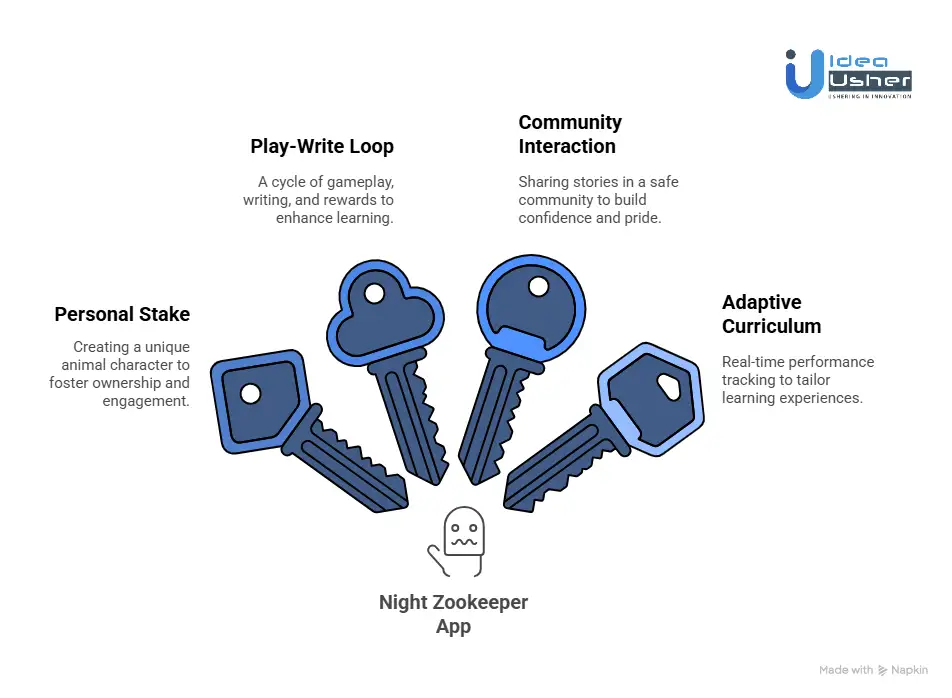
Step 1: Creating a Personal Stake
Night Zookeeper doesn’t just ask a child to “log in.” It invites them to step into a role.
User Action
The first task is to design a magical animal using a child-friendly drawing tool. They create the creature’s appearance, choose a name, and write a short description or backstory.
Why It Works
This step gives the child immediate ownership. Instead of writing about random prompts, they’re writing about a character they invented. That character becomes their avatar and a recurring figure in the story world, which gives the experience emotional weight and long-term personal investment.
Step 2: The Loop – Play, Write, Reward
The core experience is built around a tight loop that blends gameplay with literacy practice.
The Quest (Play)
Each mission is presented as a request from one of the Night Zoo characters. Children might be asked to help solve a problem, persuade a creature to join the team, or provide information that helps the heroes continue their adventure. The quests feel like games, but each one is anchored in a specific writing goal.
The Writing (Work)
To complete the mission, the child writes. The platform supports them with tools like word banks, vocabulary help, and audio pronunciation. These features keep the writing achievable for younger learners while still challenging them to do their best.
Feedback and Rewards (Motivation)
- Instant Feedback: Right after submitting, the child receives positive, encouraging system feedback, often pointing out small corrections like capital letters or spelling slips.
- Human Tutor Review: Within a short time, a real tutor reads the piece and sends back thoughtful notes. They highlight strengths, ask engaging questions to deepen the story, and offer one or two simple improvements to focus on. This personal attention is one of the platform’s biggest strengths.
- Gamified Rewards: Finishing a task earns “Orbs,” which can be spent on food, accessories, and upgrades for their magical animal. Completing enough work unlocks new areas and content, reinforcing the cycle of play and progress.
Step 3: The Community
Writing takes on more meaning when someone else reads it.
User Action: Children can publish their stories to a safe, moderated in-app community blog.
Seeing the writing of other kids, receiving positive comments, and earning likes gives children a genuine audience. For many, this is the first time their writing reaches beyond home or school, which makes them take pride in what they create.
Step 4: The Curriculum
Behind the playful surface is a carefully designed educational engine.
The System
While the child works, the app quietly evaluates their writing. It tracks accuracy, vocabulary growth, sentence structure, and overall progress tied to curriculum standards.
Why It Matters
Because the app is constantly monitoring performance, it can respond in real time. If a child repeatedly misses commas or struggles with a certain word pattern, the system introduces mini-activities or quests that target those skills. This adaptive approach keeps the experience fun while ensuring the learning stays on track and appropriately challenging.

What is the Business Model of the Night Zookeeper App?
The majority of Night Zookeeper’s revenue comes from paid subscriptions. These plans unlock all core features, including the full learning curriculum, mini games, creative writing tools, tutor feedback, progress tracking, and the moderated in-app community.
Main Subscription Tiers
Single Child Plan
Price: $12.99 per month or $119.99 per year
This tier includes full access for one child and is the standard entry point for families.
Family Plan (2–3 children)
Price: Approximately $7.50 to $9.50 per month per child, billed annually
This tier offers discounted pricing for households with multiple learners, making it more cost-effective than purchasing separate accounts.
School and Classroom Plans
Pricing: Custom quoted
Schools receive tools for managing classes, assigning work, tracking writing progress, monitoring reading levels, and handling feedback at scale. This B2B channel adds a second, more institutional revenue stream on top of consumer subscriptions.
Additional Revenue Sources
- Volume licensing for larger schools and districts
- Possible white-label partnerships with education consultants or learning providers
- Seasonal promotions and bundle pricing, which help keep acquisition costs manageable
All subscription tiers grant access to the same core system: curriculum-aligned literacy practice, personalized tutor feedback, a parent dashboard, and an ad-free, fully moderated environment.
Financial Performance
Night Zookeeper’s estimated annual revenue is roughly $2.2 million, with an approximate $112,000 revenue per employee, indicating a relatively lean operational structure.
Marketing optimizations have played a major role in the company’s growth:
- Revenue increased by around 40% after refining digital marketing through HubSpot and improved targeting.
- Customer acquisition grew by roughly 70%, suggesting strong product-market fit once families reach the platform.
- Adjustments to Google Ads strategy boosted return on ad spend by about 50%, lowering acquisition costs and improving long-term profitability.
Funding History
Night Zookeeper has raised an estimated $1.3 million across two formal funding rounds.
Key milestones include:
- A September 2014 round that marked their most recent external raise.
- An earlier round totaling £440,000 (approximately $642,000) during their post-seed growth phase.
- An additional £150,000 investment in 2012 through the Wayra accelerator, which helped establish early product development and distribution channels.
Other Successful Business Models for Gamified Creative Writing Apps
A subscription-based model like Night Zookeeper’s is dependable, but relying on a single revenue stream leaves the business exposed to market shifts. By adding complementary models, you broaden your addressable market, capture different types of users, and reduce churn-sensitive income.
Model 1: Freemium with Microtransactions
The free tier offers basic creative tools so new learners can explore the system and test essential features. Microtransactions allow users to purchase virtual currency that unlocks advanced assets and enhanced storytelling functions. A premium subscription provides full library access along with stronger feedback capabilities and exclusive challenges that can significantly improve the creative workflow.
Benchmarks
Prodigy Math uses this structure effectively in the EdTech space. Many top-grossing mobile games rely on a similar funnel with optional enhancements.
Financial Breakdown
Assumptions:
Total registered free users: 1,000,000
Free-to-play conversion: 3 percent
ARPPU (average monthly revenue per paying user): 6 dollars
- 4 dollars from subscription
- 2 dollars from microtransactions
Ad revenue from non-paying users: 0.02 dollars per user per month
Monthly Revenue Projection
- Paying users: 1,000,000 × 3 percent = 30,000
- Revenue from subscribers and in-app purchases: 30,000 × 6 dollars = 180,000 dollars
- Free-tier ad revenue: 970,000 × 0.02 dollars = 19,400 dollars
Total Estimated Monthly Revenue: approximately 199,400 dollars
Model 2: One-Time Premium App
This model begins with a single upfront payment that grants access to the core app and its primary creative features. Additional paid expansions can introduce new worlds in genres like fantasy or science fiction, along with advanced writing modules that extend the system. Seasonal content packs may also appear periodically, so the environment stays technically fresh and continuously engaging.
Benchmarks
Dr. Panda games, Monument Valley, and Minecraft use similar approaches. Parents who prefer predictable spending often favor this model.
Financial Breakdown
Assumptions:
- App price: 6.99 dollars
- Developer net after platform fees: approximately 4.90 dollars
- Target downloads in year one: 150,000
- Annual content pack buyers: 20 percent of the user base
- Average net revenue per content pack: 3.49 dollars
Revenue Projection
Year one revenue from app sales: 150,000 × 4.90 dollars = 735,000 dollars
Year two revenue from content packs:
- 150,000 × 20 percent = 30,000 packs
- 30,000 × 3.49 dollars = 104,700 dollars
Total Revenue for the first two years: 839,700 dollars (This does not include new downloads in year two.)
Model 3: Licensing and White-Label B2B Platform
This model relies on a creative writing engine that can be licensed or fully rebranded by external organizations. Schools and districts may integrate the system into their curriculum so the platform functions as a structured instructional tool. Publishing or education companies can adopt a white label version that aligns with their intellectual property and extends their technical ecosystem.
Benchmarks
Knewton and Nearpod expanded rapidly with similar B2B licensing strategies by powering other ecosystems.
Financial Breakdown
Assumptions:
- School district size: 5,000 students
- License pricing: 15 dollars per student per year (mid-range industry pricing)
- A single white-label partnership valued conservatively at 250,000 dollars per year
Revenue Projection
- Five school districts: 5 × 75,000 dollars = 375,000 dollars
- One white-label partnership: 250,000 dollars
Total Annual Revenue: 625,000 dollars
How to Build a Creative Writing App Like Night Zookeeper?
To build a creative writing app like Night Zookeeper, the process starts with a scalable narrative world that supports interactive story tasks and steady content growth. The platform then needs an adaptive engine that can analyse writing and guide each learner with targeted prompts that update in real time.
Over the years, our team has delivered multiple creative writing platforms inspired by Night Zookeeper, tailored to unique client needs.
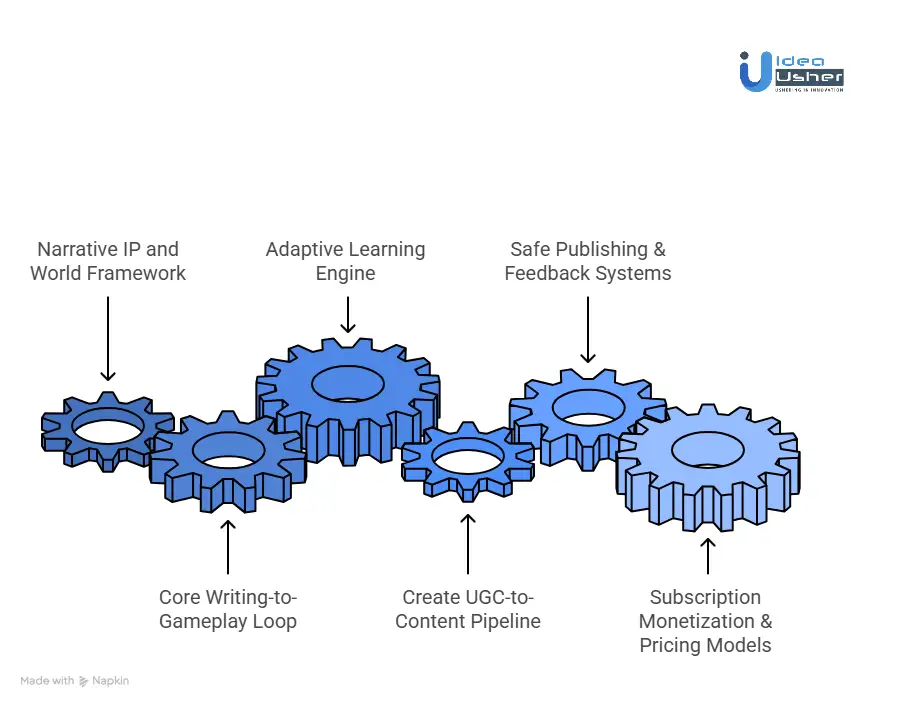
1. Narrative IP and World Framework
We start by creating a complete narrative universe with characters, lore, story arcs, and a strong visual identity that anchors the entire product. We also structure the world so it can grow with new stories and content packs, giving the platform long-term creative flexibility.
2. Core Writing-to-Gameplay Loop
Next, we design a gameplay loop where writing directly fuels progression. We map out mechanics where each writing task unlocks new missions or abilities, and we build reward systems that convert writing achievements into in-game events that keep students consistently engaged.
3. Adaptive Learning Engine
We then build an adaptive engine that evaluates writing using NLP models and adjusts prompts or challenges based on each child’s skill level. This helps us deliver a personalized curriculum flow where every learner gets writing tasks at the right difficulty and pace.
4. Create UGC-to-Content Pipeline
Our team develops tools that let children draw characters, create creatures, and submit story ideas through intuitive creation interfaces. These assets move through a structured UGC pipeline powered by drawing canvas APIs and AI tagging so they can be safely stored, organized, and used inside the game world.
5. Safe Publishing & Feedback Systems
We implement secure publishing workflows that allow students to share work in a protected space. Tutor dashboards, approval steps, and child-safe communication protocols ensure that every published piece is moderated and every interaction remains safe and educational.
6. Subscription Monetization & Pricing Models
Finally, we set up subscription systems with parent dashboards, school licensing, and classroom management tools. We design tiered content access and engagement incentives so the platform supports long-term revenue growth while remaining transparent and parent-friendly.
How a Gamified Writing App Motivates 88.2% of Writers?
A gamified writing app could motivate young writers by turning each task into a clear challenge that feels achievable and engaging. In fact, research shows that 88.2% of students pushed themselves to improve their writing when using gamified learning tools.
When progress is shown visually and feedback acts like a level-up system, the writing process becomes more interactive.
1. It Replaces Fear With a “Challenge Loop”
A blank page is daunting. A game level feels like an opportunity.
In a gamified writing app, the prompt becomes a quest:
“The Story Sprites have lost their words! Write a 50-word description of the Crystal Forest to help them.”
Justification: Gamified challenges provide clear, achievable goals. This reduces fear and increases willingness to try because the task feels like a puzzle rather than a high-pressure assignment.
2. It Makes Progress Something Kids Can See
Traditional progress is a number on paper. In a game, progress is visual, immediate, and rewarding.
In a gamified writing app, finishing a task might earn Orbs, unlock avatar items, or fill a progress bar. A child who struggles with commas sees that they are close to earning the “Comma Crusader” badge instead of seeing red marks.
Justification: Visible progress taps into a child’s desire for immediate feedback. When rewards appear right away, motivation naturally increases, which helps explain the 88.2% improvement rate.
3. It Turns Feedback Into a “Level Up” Opportunity
Traditional critique often feels personal. In games, feedback is guidance for becoming stronger.
In a gamified writing app, a coach might say, “Great start! Add three describing words to earn 50 extra Orbs,” or a teacher’s suggestion becomes a “Tip from a Senior Zookeeper.”
Justification: Reframing feedback as a path to mastery reduces defensiveness. Kids become eager to apply suggestions because improvement directly boosts their in-game status.
4. It Gives Kids a Real, Safe Audience
Writing for a teacher is a transaction. Writing for peers feels meaningful.
In a gamified writing app, kids can publish stories in a moderated hub and receive encouraging, pre-screened comments from peers.
Justification: Knowing someone will read their work creates purpose. Children naturally try harder when they feel their writing contributes to a community, not just an assignment.
Challenges to Building a Writing App Like Night Zookeeper
Having built EdTech platforms for a wide range of clients, we have seen the same core challenges appear again and again, especially for founders aiming to create a creative writing experience inspired by successes like Night Zookeeper. The vision is usually bold, but the execution requires a careful balance of technology, pedagogy, safety, and engagement.
Here are the four issues that consistently determine whether a creative writing app thrives or stalls, along with the solutions that have proven most effective.
1. Scaling Personalized Feedback
Personalized feedback is one of the strongest motivators for young writers, but it is also the most expensive part of the system. Relying solely on human tutors becomes unsustainable as the user base grows.
Our solution:
We never remove the human element. Instead, we streamline it.
- AI handles the initial review: Custom NLP tools highlight surface-level issues such as spelling mistakes, repeated phrasing, and misplaced punctuation.
- Humans focus on creativity: Tutors spend their time helping with storytelling, clarity, voice, and encouragement rather than fixing minor mechanical errors.
This structure reduces review time significantly and allows the platform to scale without ballooning operational costs.
2. Creating a Safe Community
The challenge: Kids need safe spaces online, but if a community is locked down too tightly it loses energy and interaction.
Our solution:
Safety is built into the platform’s foundation.
- Automated filtering: Real-time scanning tools such as CleanSpeak and OpenAI’s moderation models block profanity, harmful themes, and inappropriate content before it reaches any user.
- Curated interactions instead of open chat: Children can publish stories to a global blog, but everything is moderated. Comments appear as guided, positive reactions or are manually approved when written by users.
- A human moderation dashboard: Your team receives a clear and efficient dashboard for reviewing flags, approving posts, and maintaining a positive environment.
This approach keeps the community lively, creative, and safe for both kids and parents.
3. Adapting to Each Child’s Skills
Children disengage quickly when learning tools feel like tests. Adaptation needs to be subtle, supportive, and integrated into the story rather than delivered through pop-ups or worksheets.
Our solution:
The system evaluates writing in the background while the child plays. When it detects a skill gap, such as inconsistent capitalization, it responds by generating a story-driven quest.
Example: A villain has stolen all the capital letters from the Cloud Kingdom. Restore them to earn 50 Orbs.
This keeps the learning objective clear but embeds it naturally within the adventure.
4. Mixing Gameplay With Real Educational Value
Many apps lean heavily into fun at the expense of writing quality, or they focus on writing rigor while offering weak, disconnected gamification. Both approaches result in low engagement over time.
Our solution:
We design gameplay around writing goals from the start.
- Rewards connect directly to writing achievements such as word count milestones, vocabulary use, narrative structure, and stylistic variety.
- Progression depends on demonstrating real writing skills rather than performing random in-app actions.
- For example, a child unlocks a new avatar part by using a transition word correctly.
- Extra in-game currency is earned by meeting writing objectives, not by repetitive tapping.
This ensures the game remains enjoyable while writing stays central and academically meaningful.

Tools & APIs for a Writing App Like Night Zookeeper
Building an app similar to Night Zookeeper is not just about assembling cute characters and fun prompts. It requires a well-designed technical foundation that can understand a child’s writing, support imaginative gameplay, keep young users safe, and scale to a global audience. Below is a practical breakdown of the technologies that make an experience like this possible.
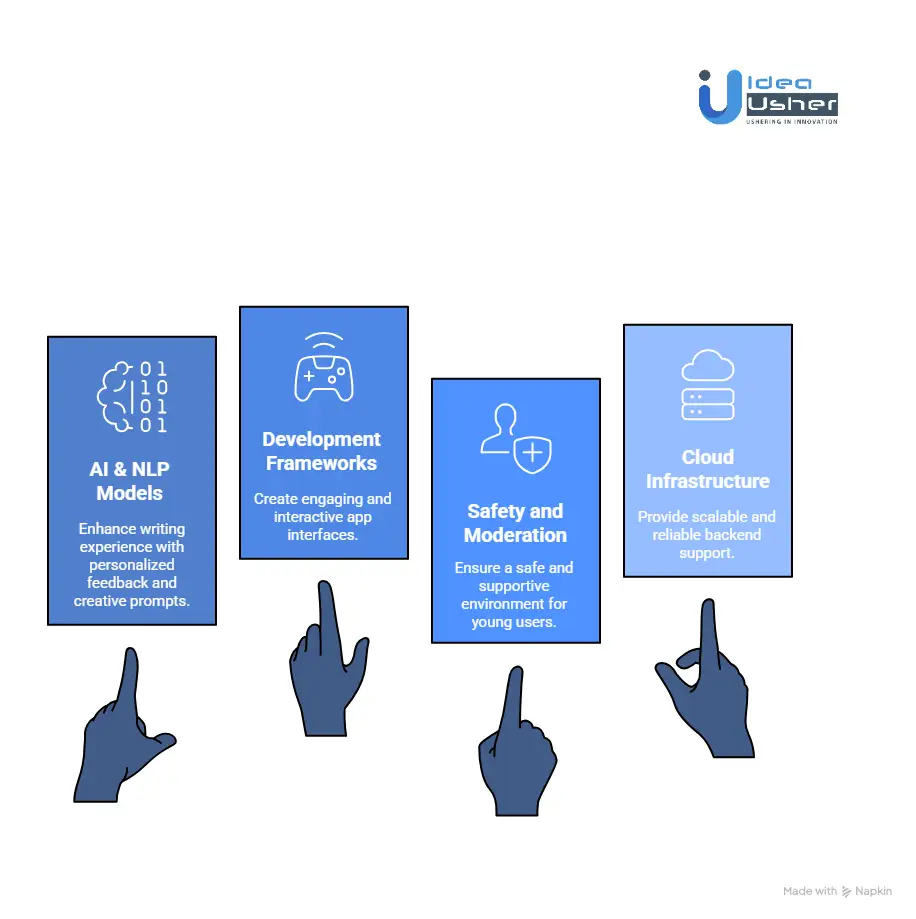
1. AI & NLP Models
To guide young writers effectively, the app needs language models that can understand context, offer encouraging feedback, and spark new ideas.
GPT-based Models (OpenAI, Anthropic)
Large language models excel at both generating and understanding text, making them ideal creative writing assistants. They can produce personalized prompts based on the characters a child invents, offer encouraging suggestions that spark new ideas, and analyze the tone and direction of a story so young writers can develop stronger plots.
Hugging Face Models (Custom Fine-Tuned Models)
Hugging Face enables the creation of specialized language tools by fine-tuning open-source models. These models can handle grammatical error correction with kid-friendly explanations, simplify text to match a child’s reading level, and check whether a story still aligns with its original prompt through semantic similarity analysis.
Custom Creativity and Writing-Quality Models
Custom-built models can help measure a child’s creative strength by evaluating vocabulary variety, identifying core story elements such as characters, conflict, and resolution, and monitoring sentiment and tone to ensure shared content remains positive and age-appropriate.
2. Development Frameworks
A writing universe becomes far more engaging when it blends storytelling with interactive, game-like elements.
Unity or Godot (Game Layer)
Unity and Godot bring the creative world to life by handling animated characters, lively environments, kids’ custom creature designs, and the interactive missions and rewards that make the experience feel like a true adventure.
React Native or Flutter (App Interface Layer)
React Native and Flutter deliver the smooth app interface that supports writing tools, menus, dashboards, and settings while providing consistent performance across iOS and Android from a single, modern and accessible codebase.
3. Safety and Moderation
An app for kids must protect them at every step. Safety is not optional and must be built into the core architecture.
CleanSpeak or Similar Profanity Filters: Acts as the first barrier, blocking profanity, sensitive information, and inappropriate usernames in real time.
OpenAI Moderation API (Context-Aware Review): This adds deeper understanding, flagging content involving hate, sexual themes, bullying, or self-harm that simple keyword filters may miss.
Human Review Tools
Even with strong AI moderation, a trained human review team is critical. A custom dashboard allows moderators to:
- Review flagged stories or comments.
- Give personalized encouragement.
- Approve stories before they are shared with the community.
A human-in-the-loop process ensures safety and maintains a supportive, authentic experience.
4. Cloud Infrastructure
To support thousands or millions of stories, drawings, and user accounts, you need a reliable backend.
AWS or Google Cloud Platform
AWS and Google Cloud provide secure and scalable foundations for your app, offering tools for user authentication through services like AWS Cognito, serverless logic with AWS Lambda, flexible databases such as DynamoDB and Firestore, and powerful data analytics capabilities through platforms like BigQuery.
Firebase or Supabase (BaaS Options)
Firebase and Supabase are ideal for smaller teams or rapid development, offering real-time databases, built-in authentication, and reliable file and media storage, which allows you to launch quickly before transitioning to a more customized backend if needed.
CDN and Caching (Cloudflare, CloudFront)
CDN and caching services like Cloudflare and CloudFront keep the app fast for users around the world by delivering images, animations, and other assets instantly and reducing performance slowdowns during high-traffic periods such as classroom sessions or writing events.
Conclusion
Creative writing apps like Night Zookeeper show how EdTech is moving toward experiences that mix storytelling with adaptive logic and steady gamified feedback. When you pair the right architecture with a clear compliance plan and a focused content engine, you create a platform that could scale smoothly and hold strong retention. Idea Usher helps you move through this process with a technical approach that stays practical and future-ready so you can enter a fast-growing education market with real confidence.
Looking to Develop a Creative Writing App Like Night Zookeeper?
IdeaUsher can guide you through each technical step of building a creative writing app like Night Zookeeper, and we will shape features such as adaptive learning paths and secure cloud-based architecture.
Our team can also integrate AI-backed feedback systems so young writers receive helpful insights in real time. With strong engineering practices, we will make sure your app runs smoothly and grows with your audience.
What we bring to your project:
- Immersive Worlds: Artists and storytellers craft rich settings that spark curiosity and keep kids engaged.
- Intelligent Learning Tools: Smart feedback systems and personalized writing paths help every child grow at their own pace.
- Reliable Engineering: With over 500,000 hours of development experience from former MAANG/FAANG engineers, we deliver stable, scalable products built to last.
Explore our past work to see how we bring ideas to life, and let’s start shaping yours.
Work with Ex-MAANG developers to build next-gen apps schedule your consultation now
FAQs
A1: Building a creative writing app of this scope usually takes 6 to 12 months because each stage requires careful planning, prototyping, and steady iteration. You will likely ship early versions to test core mechanics and then refine features such as content engines and teacher dashboards. This approach keeps the build realistic and gives your team room to adjust the product as you discover how children actually use the writing tools.
A2: You will benefit greatly from original characters and a defined story world because children respond more strongly when they feel they are stepping into a universe that belongs only to your product. An owned IP lets you extend the brand across quests, rewards, and future expansions. It will also allow you to create modular content pipelines that scale more easily as the app grows.
A3: You can build a fully automated feedback system, and it might work well for structured writing tasks. Yet a hybrid approach usually delivers more reliable learning outcomes because human tutors can spot nuance that models may miss. This mix will help you maintain pedagogical integrity while still providing students with fast, sometimes delightful guidance from AI.
A4: Yes, and a dual model will often strengthen the product because home users push engagement patterns while classrooms drive structured adoption. You may design separate flows for parents and teachers so each group sees data and controls that match their needs. This setup will also help you build recurring revenue streams since schools renew on predictable cycles, and families may stay longer when they see consistent progress.
















